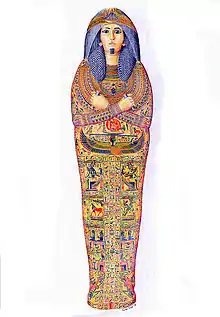Nesyamun
Nesyamun, also known as The Leeds Mummy, is an Egyptian mummy from around 1100 BC held at Leeds City Museum.

Life
Nesyamun was a priest, incense-bearer and scribe at the Egyptian temple complex at Karnak. He died in around 1100 BC.[1]
Mummification
After death, his body was preserved and entombed ready for the afterlife. His remains are now considered one of the most remarkable mummies in Britain. Nesyamun's coffins are among the best-researched of their kind.
World War 2 bombing damage
Originally part of a trio, Nesyamun was the only remaining mummy that was left unscathed after the Leeds Blitz bombing of 1941 which destroyed the front half of the museum. Nesyamun's remains were intact and suffered no damage, even though the inner lid to the coffin had been smashed during the bombings.[2]
Recent history
In 1990, the Director of Leeds City Museum invited Dr. Rosalie David to undertake a new scientific study of the mummy of Nesyamun. The multi-disciplinary team was originally set up in 1973 to research the living conditions, diseases, and causes of death of the ancient Egyptian population, and also to establish formal, non-destructive methods of examining mummified remains. The International Mummy Database founded at the Manchester Museum in 1979 is widely recognised as the major centre for the collection and storage of mummy-related information.
Since 2002, the Leeds Museum has been documenting and researching both the decoration upon the coffin, and the coffin itself. This has led to a greater understanding of the nature of the roles that Nesyamun, as a priest at the temple of Karnak, would have adopted.
In 2008, the mummy was moved to a new home at the Leeds City Museum.
Voice reconstruction
In 2020, after Nesyamun's throat and trachea were found to be remarkably well-preserved, scientists were able to reconstruct and simulate what the priest's voice may have sounded like.[3] Piero Cosi, a speech scientist who in 2016 was part of a team which roughly reconstructed the voice of another widely studied mummy, Ötzi, maintained that the reconstruction was largely speculative even with Nesyamun's almost perfectly preserved vocal tract.[4]
References
- "Nesyamun - The Leeds Mummy". BBC - A History of the World. Retrieved 16 January 2020.
- Sheerin, Joseph (22 April 2019). "3 Forgotten Stories From Leeds' Past". Leeds-List. Retrieved 16 January 2020.
- "Mummy returns: Voice of 3,000-year-old Egyptian priest brought to life". BBC News. 24 January 2020. Retrieved 24 January 2020.
- "The Mummy Speaks! Hear Sounds From the Voice of an Ancient Egyptian Priest". The New York Times. 23 January 2020. Retrieved 24 January 2020.
Further reading
| Wikimedia Commons has media related to Nesyamun. |
- Wassell, Belinda The Coffin of Nesyamun: the "Leeds Mummy", illustrations by Thomas Small. The Leeds Philosophical and Literary Society, 2008. ISBN 1-870737-21-0